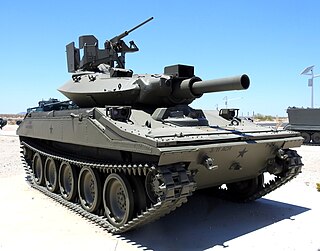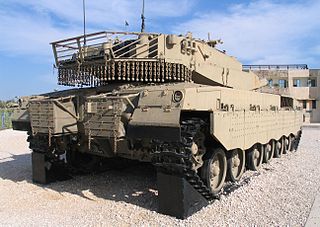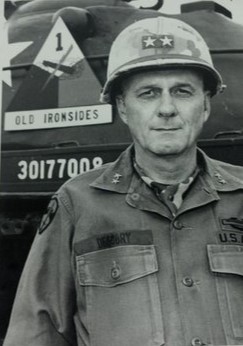
The M1 Abrams is a third-generation American main battle tank designed by Chrysler Defense and named for General Creighton Abrams. Conceived for modern armored ground warfare and now one of the heaviest tanks in service at nearly 68 short tons, it introduced several modern technologies to US armored forces, including a multifuel turbine engine, sophisticated Chobham composite armor, a computer fire control system, separate ammunition storage in a blowout compartment, and NBC protection for crew safety. Initial models of the M1 were armed with a 105 mm M68 gun, while later variants feature a license-produced Rheinmetall 120 mm L/44 designated M256.

The M551 "Sheridan" AR/AAV was a light tank developed by the United States and named after General Philip Sheridan, of American Civil War fame. It was designed to be landed by parachute and to swim across rivers. It was armed with the technically advanced but troublesome M81/M81 Modified/M81E1 152 mm gun/launcher, which fired both conventional ammunition and the MGM-51 Shillelagh guided anti-tank missile.

The 2nd Armored Division was an armored division of the United States Army. The division played important roles during World War II in the invasions of Germany, North Africa, and Sicily and in the liberation of France, Belgium, and the Netherlands. During the Cold War, the division was primarily based at Fort Hood, Texas, and had a reinforced brigade forward stationed in Garlstedt, West Germany. After participation in the Persian Gulf War, the division was inactivated in 1995.

The MBT-70 was an American–West German joint project to develop a new main battle tank during the 1960s.

Creighton Williams Abrams Jr. was a United States Army general who commanded military operations in the Vietnam War from 1968 to 1972. He was then Chief of Staff of the United States Army from 1972 until his death in 1974.

The M60 is an American second-generation main battle tank (MBT). It was officially standardized as the Tank, Combat, Full Tracked: 105-mm Gun, M60 in March 1959. Although developed from the M48 Patton, the M60 tank series was never officially christened as a Patton tank. The US Army considered it a "product-improved descendant" of the Patton tank's design. The design similarities are evident comparing the original version of the M60 and the M48A2. It has been sometimes informally grouped as a member of the Patton tank family. The United States fully committed to the MBT doctrine in 1963, when the Marine Corps retired the last (M103) heavy tank battalion. The M60 tank series became America's primary main battle tank during the Cold War, reaching a production total of 15,000 M60s. Hull production ended in 1983, but 5,400 older models were converted to the M60A3 variant ending in 1990.

The Leopard 2 is a third generation German main battle tank (MBT). Developed by Krauss-Maffei in the 1970s, the tank entered service in 1979 and replaced the earlier Leopard 1 as the main battle tank of the West German army. Various iterations of the Leopard 2 continue to be operated by the armed forces of Germany, as well as 13 other European countries, and several non-European countries, including Canada, Chile, Indonesia, and Singapore. Some operating countries have licensed the Leopard 2 design for local production and domestic development.

The Royal Ordnance L7, officially designated Gun, 105 mm, Tank, L7, is the basic model of the United Kingdom's most successful tank gun. It is a 105 mm L/52 rifled design by the Royal Ordnance Factories, intended for use in armoured fighting vehicles, replacing the older QF 20-pounder (84 mm) gun mounted on the British Centurion tank. The successful L7 gun has been fitted on many armoured vehicles, including the Centurion, the German Leopard 1 and, in an altered design, as the M68 gun in several variants of the US M48 Patton and M60.

A bustle rack is a type of storage bin mounted on combat vehicles, usually on the sides and/or rear of the turret. These racks are used to carry extra gear and supplies for the vehicle in the field, as well as give the crew a place to store their belongings so that they don't take up the already cramped space inside the vehicle.

Major General Kenneth David Nichols CBE was an officer in the United States Army, and a civil engineer who worked on the secret Manhattan Project, which developed the atomic bomb during World War II. He served as Deputy District Engineer to James C. Marshall, and from 13 August 1943 as the District Engineer of the Manhattan Engineer District. Nichols led both the uranium production facility at the Clinton Engineer Works at Oak Ridge, Tennessee, and the plutonium production facility at Hanford Engineer Works in Washington state.

The Leopardo 2E or Leopard 2A6E (E stands for España (Spanish for 'Spain')) is a variant of the German Leopard 2 main battle tank (specifically the Leopard 2A6 variant), tailored to the requirements of the Spanish army, which acquired it as part of an armament modernization program named Programa Coraza, or Program Cuirass. The acquisition program for the Leopard 2E began in 1994, five years after the cancellation of the Lince tank program that culminated in an agreement to transfer 108 Leopard 2A4s to the Spanish army in 1998 and started the local production of the Leopard 2E in December 2002. Despite postponement of production owing to the 2003 merger between Santa Bárbara Sistemas and General Dynamics, and continued manufacturing issues between 2006 and 2007, 219 Leopard 2Es have been delivered to the Spanish army.

William Kelly Harrison Jr. was a highly decorated officer in the United States Army with the rank of Lieutenant General. A graduate of the United States Military Academy, he rose through the ranks to brigadier general during World War II and distinguished himself in combat several times, while serving as the assistant division commander of the 30th Infantry Division during the Normandy Campaign and the Battle of the Bulge. Harrison was decorated with the Distinguished Service Cross, the second highest decoration of the United States military for bravery in combat, for his actions during Operation Cobra.
Lewis Stone "Bob" Sorley III is an American intelligence analyst and military historian. His books about the U.S. war in Vietnam, in which he served as an officer, have been highly influential in government circles.
The M1 Abrams main battle tank has been in service since 1980. Since then, it has gone through dozens of upgrades and been the baseline variant of several vehicles.

The United States has produced tanks since their inception in World War I, up until the present day. While there were several American experiments in tank design, the first American tanks to see service were copies of French light tanks and a joint heavy tank design with the United Kingdom.

William Robertson Desobry was a senior U.S. Army field commander in Germany during the Cold War, and a Lieutenant General in the United States Army. General Desobry was a decorated hero from World War II, and played a significant role as an advisor to the Republic of Vietnam Army and on the Army Staff during the Vietnam War. In addition to commanding a division and corps, he was the Commanding General of the Armor Center and was the President of the Tank Task Force, which led to the creation of the M1 Abrams.

The history and development of the tank in the South Korea spans the period from their adoption after World War II with the foundation of the South Korean army, into the Cold War and the present. Over this period Korea has moved from being an operator of United States designed and produced tanks to being the designer and manufacturer of first class tanks in its own right.

The FV4601 MBT-80 was a British experimental third-generation main battle tank, designed in the late 1970s to replace the Chieftain tank. It was eventually cancelled in favour of the Challenger 1, itself an evolution of the Chieftain design.

Philip Wood Lett was an American armored fighting vehicle engineer that lead the Chrysler Defense design team in the XM1 tank program, whose work resulted in the M1 Abrams tank currently in service with the U.S. Army.

Thomas William Kelly was a lieutenant general in the United States Army who served as Director for Operations (J3) on the Joint Staff from 1988 to 1991. Responsible for helping to plan the United States invasion of Panama in 1989 and Operation Desert Storm in 1991, he personally conducted the daily Pentagon press briefings at 15:00 U.S. Eastern Time during the Gulf War.



















